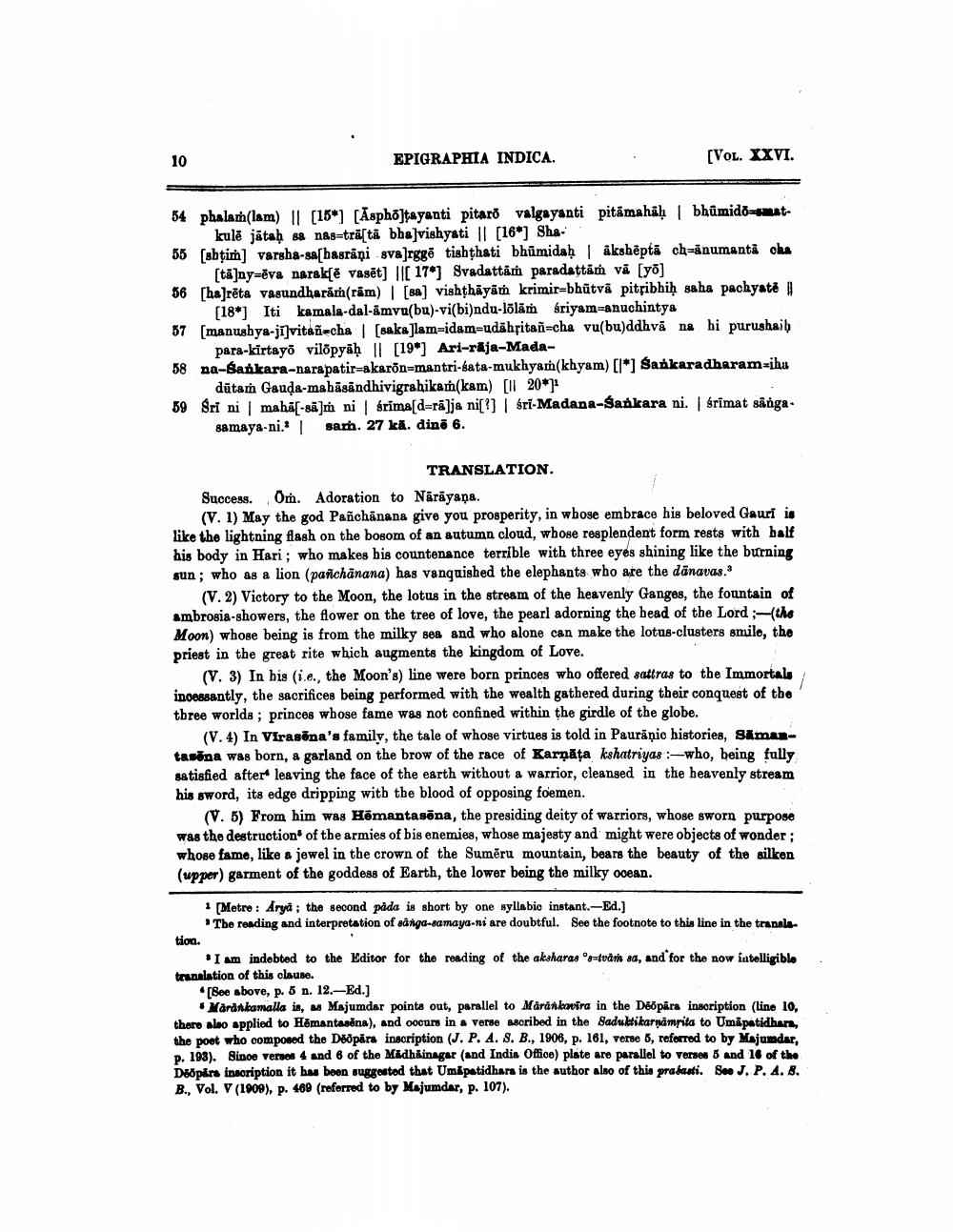________________
10
EPIGRAPHIA INDICA.
[VOL. XXVI.
54 phalath(lam) | [15] [Asphöjayanti pitaro valgayanti pitämahal | bhimid-atkulē jātaḥ sa nas-trata bha]vishyati || [16] Sha
55 [shtim] varsha-sahasrani sva]rgge tishṭhati bhumidaḥ | akshēptā ch-anumanta cha [ta]ny-eva narak[e vaset] [ 17*] Svadattam paradaṭtām vā [yō] 56 [ha]rēta vasundharam(rām) | [sa] vishṭhāyām krimir-bhūtva pitribhiḥ saha pachyate [18] Iti kamala-dal-amvu(bu)-vi(bi)ndu-löläm śriyam-anuchintya
57 [manushya-vital-cha | [sakalam-idam-udährital-cha vu(bu)ddhvi na hi purushaib para-kirtayo vilōpyaḥ || [19] Ari-rāja-Madana-Sankara-narapatir-akaron-mantri-sata-mukhyam(khyam) [*] Sankaradharam=ihu dutam Gauḍa-mahasandhivigrahikam(kam) [ 20*1
58
59 Sri ni maha[-sa]m ni | śrīma[d-rā]ja ni[?] | śri-Madana-Sankara ni. | śrīmat sanga. samaya-ni. | sarh. 27 ka. dinë 6.
TRANSLATION.
Success. Om. Adoration to Nārāyaṇa.
(V. 1) May the god Pañchanana give you prosperity, in whose embrace his beloved Gauri is like the lightning flash on the bosom of an autumn cloud, whose resplendent form rests with half his body in Hari; who makes his countenance terrible with three eyes shining like the burning sun; who as a lion (pañchanana) has vanquished the elephants who are the dänavas."
(V. 2) Victory to the Moon, the lotus in the stream of the heavenly Ganges, the fountain of ambrosia-showers, the flower on the tree of love, the pearl adorning the head of the Lord;-(the Moon) whose being is from the milky sea and who alone can make the lotus-clusters smile, the priest in the great rite which augments the kingdom of Love.
(V. 3) In his (ie., the Moon's) line were born princes who offered sattras to the Immortals incessantly, the sacrifices being performed with the wealth gathered during their conquest of the three worlds; princes whose fame was not confined within the girdle of the globe.
(V. 4) In Virasōna's family, the tale of whose virtues is told in Pauranic histories, Samantasōna was born, a garland on the brow of the race of Karṇāta kshatriyas-who, being fully satisfied after leaving the face of the earth without a warrior, cleansed in the heavenly stream his sword, its edge dripping with the blood of opposing foemen.
(V. 5) From him was Hemantasēna, the presiding deity of warriors, whose sworn purpose was the destruction of the armies of bis enemies, whose majesty and might were objects of wonder; whose fame, like a jewel in the crown of the Sumeru mountain, bears the beauty of the silken (upper) garment of the goddess of Earth, the lower being the milky ocean.
1 [Metre: Arya; the second pada is short by one syllabic instant.-Ed.]
The reading and interpretation of sanga-samaya-ni are doubtful. See the footnote to this line in the transla.
tion.
I am indebted to the Editor for the reading of the aksharas °s-tväm sa, and for the now intelligible translation of this clause.
[See above, p. 5 n. 12.-Ed.]
Märänkamalla is, as Majumdar points out, parallel to Märänkavira in the Deōpara inscription (line 10, there also applied to Hemantasena), and occurs in a verse ascribed in the Saduktikarṇamrita to Umapatidhara, the poet who composed the Dööpära inscription (J. P. A. 8. B., 1906, p. 161, verse 5, referred to by Majumdar, p. 193). Since verses 4 and 6 of the Mädhäinagar (and India Office) plate are parallel to verses 5 and 16 of the Dööpara inscription it has been suggested that Umapatidhara is the author also of this prabasti. See J. P. 4. 8. B., Vol. V (1909), p. 469 (referred to by Majumdar, p. 107).




